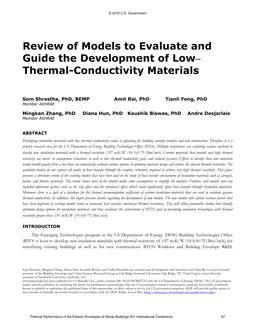Description
Developing insulation materials with low–thermal conductivity values is appealing for building envelope retrofits and new construction. Therefore, it is a priority research area for the US Department of Energy Building Technologies Office (BTO). Multiple institutions are exploring various methods to develop new insulation materials with a thermal resistivity ≥97 m⋅K/W (14 h⋅ft2⋅°F/Btu/inch). Current materials that provide such high thermal resistivity use micro- or nanoporous structures, as well as low–thermal conductivity gases and reduced pressure. Efforts to develop these new materials would benefit greatly from a tool that can numerically evaluate various options to optimize material design and achieve the desired thermal resistivity. The available models do not capture all modes of heat transfer through the complex structures required to achieve very high thermal resistivity. This paper presents a literature review of the existing models that have been used in the study of heat transfer mechanisms of insulation materials such as aerogels, foams, and fibrous materials. The review shows most of the models make some assumptions to simplify the analysis. Further, such models have not included important factors, such as the size effect and the interfacial effect, which could significantly affect heat transfer through insulation materials. Moreover, there is a lack of a database for the thermal accommodation coefficients of various insulation materials that are used to calculate gaseous thermal conductivity. In addition, this paper presents details regarding the development of new models. The new models will capture various factors that have been neglected in existing models (such as nanoscale heat transfer, interfacial thermal resistance). They will allow parametric studies that identify optimum design options for insulation materials and thus accelerate the achievement of BTO’s goal of developing insulation technologies with thermal resistivity greater than ≥97 m⋅K/W (14 h⋅ft2⋅°F/Btu/inch).
Citation: Thermal Buildings XIV 2019
Product Details
- Published:
- 2019
- Number of Pages:
- 14
- Units of Measure:
- Dual
- File Size:
- 1 file , 980 KB
- Product Code(s):
- D-Bldgs19-008




